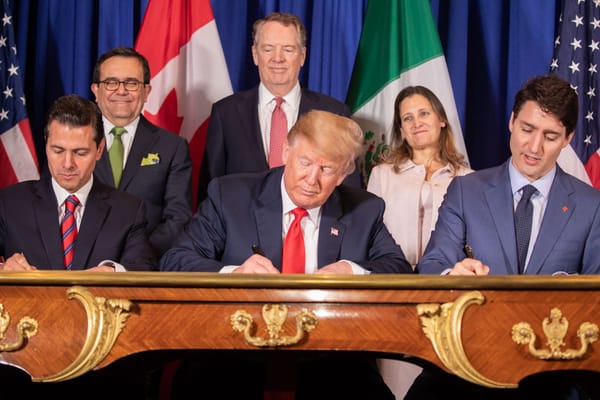Less than a month after taking the oath of office for his second term, President Donald Trump’s madman theory of trade policy is firing on all cylinders, leaving observers dazed, confused, and asking: What are tariffs—a tool to rebalance trade, raise revenue, or decouple the US economy from China’s? Or are they instead a mere instrument of leverage to extract concessions from allies and adversaries alike?
The answer is yes—all of the above. And if we are to believe the repeated claims of Trump and his top economic advisors (which we should), the new administration will use tariffs during the next four years to achieve each objective as part of a broader ambition to reform the international trading system or establish a new one.
“The uncertainty is a feature, not a bug.”
It will be a wild ride. Markets and the business press were on the brink of a breakdown amid the tariff showdown with Mexico, Canada, and China. But for all the weeping and gnashing of teeth, the policy that emerged from the fog of the trade war’s early battle—an additional 10 percent tariff on China’s goods and greater scrutiny of its de minimis shipments—is eminently reasonable and reflects what level-headed policymakers might implement. Perhaps there is a method to the madness.
Trump’s critics aren’t so sure. In addition to standard opposition from those who believe tariffs are always bad or should be used to protect only industries closely related to national security, others have raised concerns about what it all means for the future of North American trade flows. Does Trump not realize that the United States-Mexico-Canada Agreement is his trade agreement that he negotiated to replace NAFTA? Why is he threatening to impose tariffs that might blow it up? And won’t these threats undermine the prospect of a future bargain?
These criticisms ignore at least two realities. First, USMCA explicitly states that it does not preclude a signatory from “applying measures” it “considers necessary” to protect that member’s “essential security interests.” This provision is self-judging. It gives each country broad discretion to determine its essential security interests and what measures might be necessary to protect them. Trump believes enforcement of immigration laws and disruption of fentanyl trafficking to be among America’s essential security interests. Most Americans would agree. Mexico and Canada should not be surprised that Trump is using all available authorities to protect American national security.
Second, Trump’s critics fail to appreciate that USMCA was designed to be renegotiated. When Trump took office in 2017, he and Robert Lighthizer, his chief trade negotiator, had many grievances with NAFTA, which the former called the “worst trade deal ever made.” Its labor and environmental provisions were weak and unenforceable, creating arbitrage opportunities for companies to exploit cheap labor and lax regulatory standards in Mexico. It had poorly designed rule-of-origin standards that allowed content produced in third countries to free-ride on the agreement’s tariff-free treatment. Without any renegotiation mechanism, prior administrations allowed these issues to fester for decades.
USMCA not only remedied substantive problems with NAFTA, it also ensured that future issues in North American trade could be more easily improved by designing a first-of-its-kind “sunset provision.” This clause requires the countries party to the agreement to review it every six years. If any country is unsatisfied with the deal, it can insist on changes. If the other parties don’t amend the agreement to that country’s satisfaction, the agreement will automatically terminate 10 years after the review.
The sunset provision was USMCA’s most controversial provision. The Cato Institute called it a “ticking time bomb.” Pat Toomey, the only Senate Republican who voted against USMCA’s implementation, wrote that it would “introduc[e] considerable uncertainty about the future terms of trade.”
The uncertainty is a feature, not a bug. Rather than let a trade agreement of such consequence run on autopilot in perpetuity, US negotiators believed it should be continually adaptable to changing economic circumstances. The sunset provision gives the United States leverage to force Mexico and Canada to the negotiating table. As Lighthizer observed in a September 2023 essay in Foreign Affairs, it “assures that the United States will not wind up back in the position in which it found itself in 2017—23 years of suffering under a trade agreement that was riddled with loopholes, unresponsive to economic change, and terribly unfair to American workers.”
The sunset provision will ripen in 2026. Reports indicate that Trump is eager to start negotiations. US trade officials will be able to address several issues during the review process. Trump says he wants to further strengthen the rule-of-origin standards for automobiles. Others have raised concerns about China’s efforts to use Mexico and Canada as backdoors to evade tariffs and access the US market on favorable terms. As part of negotiations, the United States should urge the other parties to restrict Chinese investments and exclude companies that receive subsidies from the Chinese government from the agreement. The updated agreement should also exclude products with Chinese content from receiving tariff-free treatment.
Will Trump and his trade officials improve USMCA along these lines in negotiations? One should hope. Having the foresight to design a trade agreement to be temporary rather than perpetual at least gives them the opportunity to do so.
